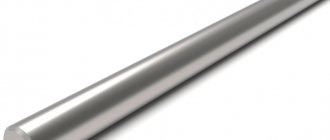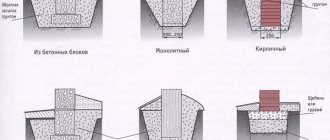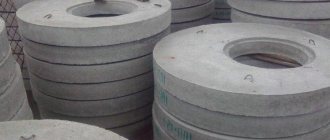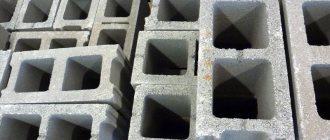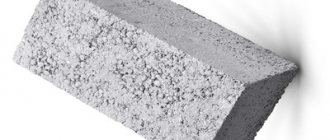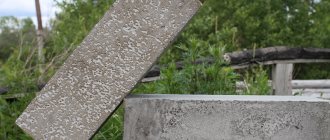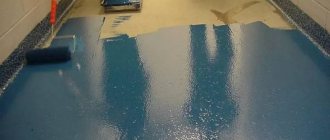A neat, well-groomed lawn with green grass is considered one of the most popular solutions in the field of landscape design. To ensure that the aesthetic appearance of the lawn looks good for as long as possible, and caring for it does not take a huge amount of time, eco-parking concrete lawn grates from various manufacturers are used. Why this is needed and how to properly lay such material we will discuss in this article. We will also reveal the main advantages of concrete grating and tell you in what cases it is used.
Do-it-yourself lawn lattice. Laying lawn grating on the site
A neatly trimmed lawn with bright green grass - what could be better to decorate a summer cottage or area near a house or shop?
But a lawn planted with your own hands in dug up soil does not look so neat, and as a result of walking on it, as well as under the influence of weather factors, very soon it will completely lose its appearance, the grass will turn yellow and thin out. A lawn grid is used for this.
Fortunately, there are modern means with which you can create a perfectly smooth lawn that will not change its appearance even over a long time.
The lawn grate is a special design in the form of modules made of concrete or plastic, connected to each other with latches. The main purpose of the trellis is to protect plant roots and strengthen the soil.
Most often, a lattice is purchased for a summer residence. It can be used for parking, playgrounds and other places in the garden.
Advantages of a lawn lattice
- The light weight of the grill makes it easy to transport on any car.
- The convenient design facilitates quick assembly right on site.
- High frost resistance (up to -40 C).
- Easy to maintain. After laying the grate, the lawn is not deformed, cutting is quick and easy. The use of any tools is allowed (trimmers, gasoline and electric lawn mowers, gas mowers).
- Environmental friendliness. Lawn mesh is produced from environmentally friendly material.
Types of lawn gratings
Currently, two types of gratings are offered on the building materials market: plastic and concrete. Therefore, the buyer always faces a difficult question of choice.
Plastic mesh for lawn
Green areas made of plastic lattice have a more neat appearance due to the thin walls of the plastic cells. Laying a plastic lawn grate is easier and does not require the use of special equipment.
With all other indicators of strength and reliability being equal, a plastic lattice allows you to create the most natural lawn.
Concrete lawn grate
Concrete lawn gratings are the ancestors of these devices. The main advantages of a concrete structure are its high strength and reliability.
In addition, concrete lawn gratings are more suitable for use in areas with dense soils, where it is not possible to create optimal groundwater drainage and good water drainage in the event of heavy rainfall.
Concrete gratings are not so demanding in terms of soil preparation before installation. They are also distinguished by their low price.
But at the same time, such a lawn does not look very attractive in a parking lot, because... is a green area with concrete islands.
Do-it-yourself lawn grating installation
How to lay a lawn grate without the help of third parties? In fact, this is a rather painstaking and complex process.
But if you follow the following algorithm of actions, you can create an aesthetically attractive and reliable lawn yourself:
- We prepare the area. We select the soil until a depression with a depth of 9 to 11 cm is formed.
- We level the surfaces and compact the soil.
- We fasten the edges of the grille. To do this, we place ordinary stones in the concrete solution or use anchors attached to the ground.
- We create the underlying layer. Pour a layer of mixture 3-5 cm high, which consists of 80% gravel and 20% soil.
- We lay a layer of road mesh or geotextile on the gravel.
- As an additional layer we line a small mesh.
- Now we lay the lawn lattice with the wide surface down and the lattice side up. We shift the rows by one cell towards each other. We fasten the modules together at an angle of 45 degrees so that they can easily take the position we need.
- If necessary, we adjust the size of the grating to the desired parameter using a carbide circular saw used to shorten the modules.
- Fill the grate with a mixture of medium-sized soil and gravel (in equal proportions).
- We sow lawn grass and don’t forget to water it regularly.
- Keep in mind that you should sow the seeds 2-3 cm below the very top of the trellis. This will prevent damage to the grass.
If you followed all the steps correctly, very soon you will be enjoying the lush and vibrant grass that you planted yourself.
How is installation carried out?
The technology for laying concrete tiles relative to their plastic counterparts is complicated by the weight parameters of the grating. The weight of some structures does not allow installation alone. In general, installation is similar to laying paving slabs. And it is carried out according to a time-tested algorithm:
- Site preparation:
- marking the territory;
- cleaning the area from stones, debris, glass;
- setting a level with a level;
- destruction of weeds (mechanical or chemical means).
- Removing a layer of turf (30 cm), leveling the bottom.
- Filling of crushed stone to a level of 10 cm with periodic watering and compaction.
- Preparing a sand cushion (7-10 cm) with periodic watering and compaction.
- Installing the cells to the required depth by tapping with a mallet. At this stage, you should carefully ensure that the level of each cell corresponds to the same height.
- Compacting with special equipment.
- Filling the structure with soil composition, sowing lawn grass.
Since the cells have technical holes that do not allow water to accumulate, in this case it is not necessary to maintain the level of inclination for water drainage.
In conditions of total cutting down of green spaces and the development of urban spaces, even a small island of lush greenery makes an invaluable contribution to air purification. With a concrete lawn trellis, organizing your small oasis is easy.
Advantages of vibro-compressed concrete gratings
In order for the still doubting buyer to quickly decide on the choice of a suitable covering for his parking space, we can cite the most basic advantages of a concrete grate that will help make the choice.
Beauty is an undoubted advantage of this coating, which can be appreciated by true aesthetes who are very sensitive to the external aspect. But, taking into account the fact that vibro-pressed concrete gratings have quite a lot of advantages, we can discard the plus of a purely aesthetic orientation and move on to the more serious advantages of this coating, which relate specifically to the practical side:
A lawn grating made of vibro-pressed concrete has quite high strength and reliability, and this indicator cannot in any way be affected by the season of operation. Weather conditions are simply not capable of harming the condition of the concrete grating. Vibro-pressed concrete can withstand even the most severe operating conditions, which makes the life of this coating very, very long; Concrete grating is a very stable coating that will not succumb to the harmful effects of ultraviolet radiation or severe frosts. It should also be mentioned that even sudden temperature changes will not affect the condition of the coating; A huge advantage of using this particular coating is its drainage ability. This means that moisture will never accumulate on the surface of an area equipped with a concrete lawn grid.
This is very important, especially in conditions where the coating is used to arrange a parking space, because you can be sure that the nearest rainstorm will not plunge the vehicle’s wheels into the mud. Products made from vibrocompressed concrete have a very important property that car owners will appreciate. We are talking about high anti-slip properties
This property is especially valuable in conditions of icing of the surface. You can be sure that when leaving your parking space, the car will not skid. The next very important advantage of a concrete lawn grid is that it protects the soil from the destructive processes of erosion and leaching. This is also very important when arranging a parking lot. The vehicle can get stuck and sag, which will cause many problems and difficulties. A lattice made of vibro-pressed concrete prevents processes that are destructive to the soil. Concrete grating is an environmentally friendly coating that will appeal to people who care. They don’t have to worry about this at all, since the coating is environmentally friendly and will not cause any harm to the environment. The influence of natural factors does not have a great influence on the coating due to its resistance to their influence. Also, as some of the main advantages, you can indicate those properties that will definitely appeal to buyers who do not want to spend a lot, and also want to carry out installation without resorting to the services of hired workers. The lawn grate is a very lightweight covering and is also very easy to install, which makes installation much easier and allows you to do the job alone. Another advantage is that this coverage is not expensive, which allows it to be purchased by a wide variety of buyers with different financial capabilities.
The advantages of lawn grating presented above can really impress any buyer who wants to arrange a parking lot for his vehicle.
Advantages and disadvantages
The lawn lattice stands out with its advantages against the background of the asphalt covering. Concrete composition is an excellent alternative to plastic modules, which are inferior in strength to their heavier counterparts. This product protects the lawn in areas of frequent use (for example, parking lots) by preventing the grass from being crushed, the root system of which is located below the level of the active surface of the tile.
The advantages of geogrids do not end there, but are complemented by the following advantages:
- unhindered possibility of irrigation with rainwater directly to the root system;
- variability of sizes, shapes of cells and color palette, allowing you to select products for individual landscape design;
- permissibility of widespread use instead of conventional tiles or paving stones;
- long service life (manufacturer declared at least 25 years);
- resistance of products to the negative influence of environmental factors - ultraviolet radiation and temperature changes.
However, ecotiles also have their disadvantages, which should be taken into account before purchasing them:
- the width of the product cells is quite massive, not always suitable for complementing elegant architectural compositions;
- installation of slabs involves installation in the soil, which requires additional preparatory work.
Installing lawn gratings will be an ideal solution for decorating the area, and will also help eradicate the problem of waterlogging in areas prone to excessive moisture or flooding
Recommendations for selection
Despite the fact that in the store the seller will find a lot of advantages for each material, you should not buy the first thing they offer you. Important criteria for purchasing a lawn grate are 2 indicators: size and load. In this case, one cannot ignore the form.
As a rule, concrete products of different shapes imply different weight loads. Concrete honeycomb gratings can support weights of up to 20 tons. They are bought for lawns and parking when arranging sidewalks, parking lots for cars, and children's playgrounds. Square-shaped analogues support weights of up to 400 tons, they are designed for installation in areas with the most intense traffic.
To purchase the product correctly, it is important to consider other nuances. For example, it is important to take into account the safety factor, adding 30-40% to the maximum possible weight per 1 sq.
m of grating specified by the seller. If the grate is needed not for parking, but for lawns, just add 10%
If you want to buy polymer products, you should pay attention to the composition of the material
You cannot buy cheap types of plastic: the cheapness of the product is explained by the inclusion of various impurities in the composition. As a result, such a lawn will not last long; it will quickly break down. Geogrid for parking should be made of 100% polyethylene. The weight of the material should be 6 kg per 1 sq. m, the walls should be 5 mm thick.
To ensure that the fastening is reliable and does not create unforeseen situations, a “lock-groove” system is chosen. In order not to worry about temperature changes, it is worth purchasing options with temperature cells
At the same time, pay attention to the cost. A good plastic frame will not be cheap, it is not on sale, it is not included in the sale
If you plan to purchase building material for arranging a garden plot, take options for constructing a lawn designed for average weight. In order for the structure to last longer, the type of fastening and temperature cells are selected as in the previous version. Sometimes you need to create a lawn with different operational properties (for example, for a garden, a pedestrian area and a parking lot). In this case, they try to choose a material that can withstand both medium and heavy weight loads.
For example, you can purchase a concrete type of grating or an analogue made from a rigid polymer. The material must withstand at least 12 tons per 1 sq. m. Maximum it should withstand up to 25 tons per square meter. m. If the choice fell on concrete products, it is preferable to take one that was obtained by vibrocompression. It is stronger and more durable and will withstand any weight load.
To learn how to install a lawn grate, see the following video.
Types of geogrids: design and material of manufacture
Depending on the design, honeycomb parking tiles can be flat or three-dimensional. The first design option is used for mechanical fixation of the filler, which is poured into the honeycomb. Possessing high strength in all directions, the flat frame is able to withstand significant dynamic and static impacts. This is an ideal option for concrete parking lots with heavy loads.
The height of the cells is in the range of 5-30 cm. The diagonal has the same values. The size of the product is selected based on the type of material being filled, which has a different structure and fractionation, and also depends on the steepness of the slope. The service life of the material is 50 years.
More in demand are volumetric lawn grates for parking lots, the price of which is proportional to the size of the product. Using this design, you can strengthen hillsides, swamps, river banks, and also create barriers to soil erosion and sliding.
There are different lawn trellis options for different types of landscapes.
A volumetric geogrid can be fixed using various elements. Mounting anchors made of steel reinforcement with a diameter of 10-14 mm and a length of 50-110 mm are often used. Their fastening occurs in the stretched position of the product. After filling the cells with material, the anchors are removed. This is how the lawn path for the paths in the country is attached.
For surfaces with heavy soil and steep slopes, it is advisable to use a polymer cable and prefabricated anchors. The structure can be connected to the ground surface using load-bearing anchors. The grating walls are connected using steel staples and a stapler.
Stages of work
- The bottom of the pit is compacted, the walls can be strengthened with brickwork.
- To level the bottom, a sand cushion 100 mm thick is poured in compacted form. Geotextiles are laid on top of it, extending onto the walls of the pit. Geofabric strips should overlap each other by 100-150 mm.
- Gravel or crushed stone is mixed with sand in a ratio of 4:1 and compacted.
- Lay (with a tamper) a leveling layer 20-40 mm thick, consisting of fine crushed stone (5-10 mm) and sand.
- Cellular modules are installed on a prepared base, carefully joining each other.
- Fertile soil is poured into the voids of the modules, preferably a mixture of peat and sand. It is necessary to leave 5 mm to the top of the cells.
- The area or path is sown with grass, watering is done in the morning and evening using a spray nozzle.
- Lawn care - periodic mowing.
Tip: when designing and constructing driveways and eco-parking areas, avoid unnecessary turns of the car so as not to subject the grass and concrete modules to increased loads. The rectangular or square shape of parking lots and platforms ensures easy calculation of the amount of materials used and convenient installation.
Lawn concrete grating is a system of cellular modules connected to each other by locks. It protects the root system of plants from mechanical stress. After a vehicle or pedestrian has passed over the lawn, the grass is restored immediately or after watering.
The concrete grating performs the following functions:
- maintains the attractive appearance of the lawn;
- ensures evenness of the lawn;
- protects the root system of plants;
- strengthens the soil;
- prevents the formation of floods.
The structure is installed shallowly in the ground. A drainage layer is laid under it to protect the soil from waterlogging.
25 years of “service experience” for a concrete grating is far from the limit!
Additional “advantages”: a concrete lawn grate, the price of which is affordable for any developer, is not subject to the negative effects of ultraviolet radiation, tolerates temperature changes well and will last 25 years without any maintenance costs.
Unlike paving slabs, on an area lined with such a coating you will definitely not have to walk through puddles. The permeable surface of the grid tiles ensures timely drainage of water during rain. In addition, lawn lattice is successfully used to strengthen slopes.
Laying a concrete lattice is a guarantee that the car will not slip when leaving the parking lot, and the planted plant seeds will definitely germinate and delight the eye with the bright colors of nature!
It is quite difficult for a person without special skills to lay a concrete grating, but the slightest mistake will take away YEARS OF SERVICE! Only specialists with experience will perform competent and high-quality installation - so why not contact them IMMEDIATELY?
Leroy lawn grate. Description
Lawn lattice, or covering for garden paths, are modules made of high-strength polyethylene (frost-resistant polypropylene), reminiscent of a three-dimensional honeycomb. The height of the cell walls creates chambers for the soil, which are designed to withstand the load of a person or car, and the pressure on the soil becomes minimal. Decorative and practical design of the combined cells, each part of which is equipped with a “hook-and-eye” system for firmly connecting the modules into a single surface. Lawn lattice (geogrid) is intended for improvement of pedestrian roads, parking lots, exhibition and fair venues, strengthening and improvement of roadsides and earthen embankments. Also, a lawn grid can be used to strengthen the area around sports facilities, camping sites, and other earthen areas with grass. The grid is easy to handle and assemble, protects the soil from washing out and weathering, is resistant to mechanical loads, and evenly distributes weight over the entire coverage area, which provides a perfectly flat surface without damaging the root system of the lawn. Advice for summer residents - you definitely won’t be able to find a better covering for garden paths. Geogrid is not only a cheap covering for garden paths, but also an excellent alternative to paving stones, and even more so to ugly and anti-ecological asphalt! When preparing the base for laying a lawn grating, it is necessary to take into account the nature of the future load: the heavier the load, the more massive the foundations and more serious tamping. Before installing the grid, it is necessary to lay a 20-30 cm sand-gravel cushion, then a layer of geotextile with a density of at least 160 g/m2 and apply a 4-6 cm leveling layer of a mixture of sand and gravel. The grid is installed by connecting individual cells to each other in rows on the left to the right. If necessary, the grate can be cut with a circular saw or jigsaw. At the final stage, the grid cells are filled with fertile soil and lawn grass is planted. It is not recommended to use lawn grids for surfaces with a slope of more than 10% and increased maneuvering movement. Advantages and characteristics: high mechanical strength; durability and optimal price; environmental friendliness and safety.
What is a geogrid for parking
A lawn grate, the cost of which depends on the type and material of manufacture, is a building product with a honeycomb structure. It is made of geosynthetic polymer or concrete. The cell size is in a wide range, which is selected depending on the area of use of the grid. The length, width and height of the honeycomb are also different - the optimal values are selected based on the total load on the structure.
The lawn grating should be selected based on the expected load on the surface where it will be used.
This polymer building material is used as a covering for sidewalks, parking lots, parking lots and lawns. It has also proven itself well as a reinforcing frame for unstable soil. The material is increasingly being used instead of paving slabs. A lawn trellis is a more economical and environmentally friendly solution.
When stretched, this product creates a stable and durable reinforcing frame, the cells of which can be filled with sand, crushed stone, soil or other material that is fixed and limited in movement. Using concrete mortar as a filler, you can create a monolithic platform. If you pour marble chips into the honeycomb, the result will be a decorative path.
The main advantages of geogrid are the following indicators:
- increased strength of the frame due to reliable fastening of polymer tapes in a checkerboard pattern;
- obstacle to soil shifts;
- resistance to temperature changes, moisture and corrosion;
- providing comfortable conditions for plant growth;
- resistance to mechanical loads;
- the ability to pass moisture absorbed into the soil, which eliminates the formation of puddles;
Concrete lawn grating is highly durable and durable.
- repetition of the distinctive features of the soil relief;
- immunity to chemical influences, mold and rodents;
- environmental friendliness of the material;
- preventing siltation of the territory;
- ease and simplicity of installation and dismantling;
- plastic products can be recycled;
- affordable price.
Thanks to the cellular structure and resistance to mechanical stress, the load is evenly distributed over the entire area of the roadway. Geogrid can significantly increase the strength of a parking lot surface.
On a note! Since each type of grating has a different strength factor, when choosing, it is recommended to take into account the operating characteristics of the parking lot.
Using lawn grates to create parking spaces is an increasingly popular trend.
Description and purpose of gratings
The lawn grate was developed more than 10 years ago. It is a horizontally located structure, which is assembled from fastened blocks. Each part has many cells intended for planting. Its walls can withstand very heavy weight and can withstand frequent loads.
On a note! Modules can cover the required space of any size and shape.
Lawn nets are very good for parking vehicles, because cars have a destructive effect on the soil. Pedestrian and bicycle paths, driveways, areas for sports and children's games, fields for horse racing, and lines near railway tracks are also paved with gratings.
Lawn grate
The undeniable advantages of the lawn design:
- a smooth, non-slip surface of the area is ensured;
- due to moisture flowing into the holes, no puddles form and there is no dirt;
- the soil is protected from erosion by precipitation, wind, and subsidence under heavy weight;
- With simple care, the lawn looks healthy, without bald spots;
- plants receive everything they need for growth and are not injured inside the cells.
Negative aspects of installing cellular blocks:
- not suitable for long-term parking or placing large objects that block sunlight;
- You cannot walk on them in shoes with thin heels.
The principle of operation of all structures is the same: the modules are laid in the selected location, the cells are filled with fertile soil, into which grass seeds are added. Gravel is partially poured into the grate for parking cars on the lawn.
Note! The owner will need care of the same complexity as for a regular lawn: periodic watering, fertilizing, mowing excess blades of grass, removing dry and rotten plants, and debris. Enterprises produce different types of lawn gratings, differing in:
Enterprises produce different types of lawn gratings, differing in:
- Material of manufacture - concrete or plastic is used in production. The wall thickness, strength, durability, and weight of the structure depend on the material;
- The height of the lattice module is optimally 4-5 cm or more, low walls will not hold the soil;
- Shape and size of cells.
Geogrid for parking: an innovative new generation material
Lawn parking grate is a new material designed for landscaping applications. The product is very popular due to the fact that it helps to perform various landscaping work. This new development is successfully used for reinforcement, preventing soil shifts, strengthening slopes, and ensures strength, reliability and long-term operation of parking areas. This article contains information about the features and types of products, as well as tips and recommendations for choosing and installing structures. Geogrid: characteristics, meshes for strengthening slopes (read more)
Geogrid is an innovative modern material designed for arranging parking lots, paths and lawns on site.
Preparing the surface for installation
It is very easy to install a lawn grate yourself. First you need to prepare the base for laying the mesh.
It is worth following the step-by-step instructions:
- First you need to determine the height of the grate and select soil at a height of + 5 cm for backfilling the base - 25-30 cm. The entire surface must be flat. Cover the bottom of the “pit” with geotextile.
- Having placed the beacons on the level, fill the area with a thin layer of fine gravel 3-4 cm thick - using a vibrating machine.
- The base is almost ready. Now you need to water the base and wait until it compacts. The result is a level at which the grid can be laid.
Module classification
Concrete gratings can be classified according to several criteria. Initially, modules differ in the production method, which affects the strength of the product, albeit slightly.
Manufacturing methods
As already mentioned, concrete lawn products are produced in 2 ways: casting and vibrocompression.
Comparative characteristics, production method, and type of modules obtained are in the table below:
| Advantages | Flaws | |
| Vibration pressing |
|
|
| Casting |
|
|
Form
The most common are 2 forms of concrete geogrids:
- Cellular. Grids of this shape can withstand vertical loads of up to 20 t/m2. They are used in the construction of passenger vehicle parks, children's playgrounds, bicycle and pedestrian paths.
Cellular concrete modules
- Square. Modules with this cell shape are capable of withstanding loads of up to 400 t/m2 and are used for the development of areas with increased load, for example, for the design of transport cargo terminals.
In the photo, the parking area is lined with modules with square-shaped cells
Color
Since the lattice is rarely actively visible under the grass, and is rather a general background, there is no need for special color solutions in the manufacture of modules.
Coloring can be done in bulk, at the stage of mixing the solution. This procedure slightly increases the cost of the finished product, so gray (cement) colored modules have the lowest price.
Adding a coloring pigment to a concrete solution increases the cost of finished lattice modules
Laying
The technology for creating a frame lawn using a lawn grid is extremely simple, and therefore anyone can master it. To correctly install the grille yourself, you must follow the step-by-step installation diagram presented below.
- They buy material based on calculations of the required quantity, taking into account the given weight load.
- Using pegs and construction cord, mark the future lawn area.
- Soil is removed from the entire area of the marked area, and the thickness of the removed layer to create parking lots is usually from 25 to 35 cm.
- The surface is leveled and compacted, strengthening the boundaries of the dug area.
- A so-called sand and gravel cushion is placed at the bottom of the dug “pit”, the thickness of which should be at least 25-40 cm (for pedestrian areas 25, entrance to the garage 35, light cars 40, cargo - 50 cm).
- The pillow is moistened with water, after which it is compacted and the surface is leveled.
- The walls and bottom can be reinforced with a small layer of concrete; sometimes the walls are reinforced with brickwork.
- Geotextiles are placed on top of the cushion, which will prevent the growth of weeds and the washing out of soil from the cellular frame under the influence of precipitation, as well as when snow melts.
- A layer of sand at least 3-5 cm thick is poured on top of the geofabric. This layer is leveling; it will allow all elements to be leveled when installing the grating.
- Concrete modules are laid on top of the leveling layer. Using a rubber mallet, trim the heights of the protruding elements.
- When laying out concrete modules, the correct placement is checked using a building level.
- Soil is poured into the cells of the laid frame, filling them approximately halfway, after which the soil is moistened for shrinkage.
- Next, the soil is added and the seeds are sown and the soil is moistened.
Creation of lawn tiles and further maintenance of the parking lot
After laying the lawn lattice, the lawn is arranged. To do this, a fertile soil mixture with fertilizer is poured into each cell in two stages. The first layer fills 2/3 of the height of the honeycomb, compacted and watered abundantly. Then a top layer is formed, the soil of which can be mixed in advance with lawn grass seeds. Upon completion of the work, the soil is watered abundantly. For green parking, it is recommended to use low-growing perennial grasses that grow in low light conditions, such as red fescue, perennial ryegrass or bluegrass.
On a note! You should not use the parking lot until the grass cushion has formed.
Eco-parking does not require special care. As the grass grows, it needs to be mowed, fed and watered periodically. The site must be cleared of debris and unnecessary growth. If gaps appear in the cells, add soil to them and sow grass seeds.
An area equipped with a lawn lattice does not require much maintenance in the future.
In order for the product to last longer, you need to purchase material that can withstand all the vehicles that will be located in the parking lot. Otherwise, if individual elements are damaged due to excessive load, there will be a need to re-equip the site.
In areas with high humidity, you can create an unpaved green parking lot. In this case, the lawn parking grate is chosen exclusively of the volumetric type. It is immediately filled 2/3 with gravel or crushed stone. Then it is covered with soil base mixed with grass seeds. Such parking, in comparison with lawn parking, is more resistant to loads. This option eliminates the formation of uneven ground.
Geogrid for parking, the price of which starts from 400 rubles/m², is an innovative material that is widely used in private housing construction. Parking for vehicles, paths or slopes designed using such products will become a real decoration of the garden plot, which will simultaneously increase the level of comfort and make it possible to implement original design ideas.
Laying lawn grating
The sequence of installing a lawn grate is quite trivial, and installing a lawn grate with your own hands will not be difficult even for an inexperienced summer resident.
Do-it-yourself lawn grating technology
1. We mark the area where we plan to install the grille. At the same time, we determine the purpose for which a particular site will be used. This could be a simple lawn that will be used, for example, as a sports ground, or this area can become a parking lot for a car or even a helicopter. Based on certain goals, we choose the type of lawn grate. Regardless of whether you are laying a plastic lawn lattice or you have chosen concrete, the further course of action does not depend on the material, so feel free to continue working.
2. Having marked the area, you should remove the soil from it to a certain depth. Calculating the required depth is not difficult. The depth of the pit is determined by the following components:
- The height of the gravel cushion is on average about 5-20 cm - the specific value depends on the expected level of loads. If you plan to organize a parking space on a laid lawn grid, then you should use this parameter to the maximum, since situations may arise when you need to park not a passenger car, but, for example, special equipment or a minibus.
- The height of the leveling layer, which is no more than 2-3 cm.
- The height of the lawn grid is about 5 cm.
In total, in the general case, we will need to remove about 28 cm of soil from the area.
3. Having completed the preparatory earthworks, the soil should be compacted and the boundaries of the dug area should be strengthened. Strengthening can be done either by laying stones or bricks, or by pouring concrete.
4. The next step in the process of laying a lawn lattice is to add a cushion, which is a mixture of gravel and sand. Sand is necessary so that crushed stone or gravel lies tightly and does not sag under load.
5. We lay geotextiles on top of the gravel pad, which will protect the lawn from the germination of unnecessary weeds. Next, a thin leveling layer of sand (2-3 cm) is poured.
Attention! Geotextiles, in addition to protecting against weeds, are used as a separating layer. It does not allow soil to penetrate into the bed of crushed stone and gravel, thereby protecting against the formation of holes and failures, and also performs a drainage function.. 6
Now let's move on to installation. We will consider the option of laying a plastic lawn grate. Each module of such a lattice has connecting elements, through which the modules are assembled into a monolithic fabric
6. Now let's move on to installation. We will consider the option of laying a plastic lawn grate. Each module of such a lattice has connecting elements, through which the modules are assembled into a monolithic fabric.
In places where the entire grille module does not fit, use a hacksaw to cut out a piece of the required size. The standard dimensions of one plastic grill module are 40 by 60 cm.
7. And finally, the last stage - we fill the cells with fertile soil to the very top. It is advisable that the soil be light; compost and peat are best suited. We carefully water the entire area for the lawn, while the loose soil will settle a little. Now we sow the soil with lawn grass or roll out the finished lawn.
Areas of application
Eco-parking is far from the only place where such cells can be used. They are also indispensable in other conditions:
- A city where there is a special need for water drainage.
- In areas where there is a need to move liquid over a certain distance. In this case, such building material is the most practical and cheapest.
- Drainage of melt and rain water from roofs. Through the concrete grate, the liquid penetrates into the ditch and flows into the sewer.
- In areas fenced with concrete trays, where there is never waterlogging.
- In southern regions where areas need to be watered frequently, it is useful to have a good drainage system, since the flow of liquid will be controlled.
Return to contents
